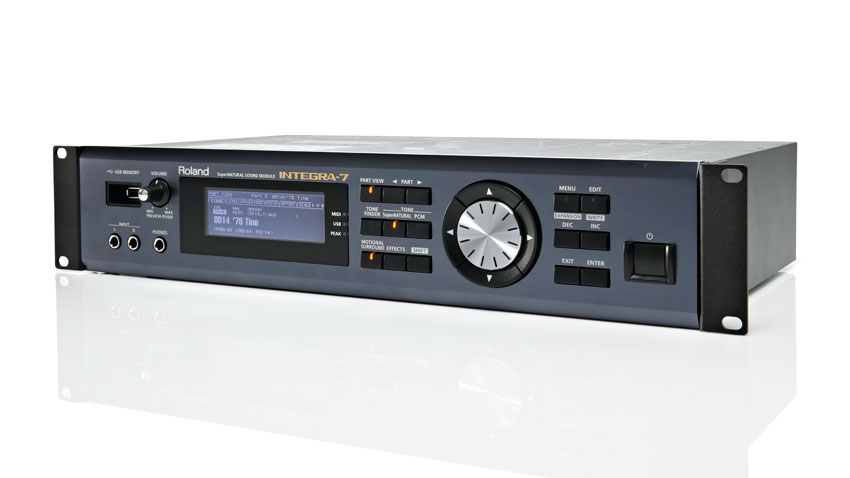MusicRadar Verdict
A sonic chameleon - a cross platform DAW editor/tablet app would complete this killer package.
Pros
- +
A sonic chameleon that excels at most sound design tasks. iPad editor for the synth engine plus Motional Surround Sound. Sensibly priced and takes up little studio space.
Cons
- -
Have to load two whole cards to use single sounds from each. Lacks cross-platform VST editor. Limited iPad editing ability. Max polyphony is 128 notes.
MusicRadar's got your back

Roland Integra-7 Sound Module

Roland Integra-7 Sound Module
The Integra-7 is a two-unit rack synth featuring all the sounds from the highly regarded XV5080 module, Supernatural sounds from the latest Jupiter-50/80 synths and V-Drums, plus ALL 12 virtual SRX cards and seven new virtual expansion cards.
"The layout is tidy and surprisingly logical to navigate and it's easy enough to get to grasp without looking at the manual"
Its layout is tidy and surprisingly logical to navigate and it's easy enough to get to grasp without looking at the manual. New panel features not found on older Roland models include a USB memory slot, a clear blue backlit screen and the combined scroll wheel/cursor array taken from the Jupiter-80. There are no real-time controls, making an external editor essential. Oh and build quality is excellent.
With 16-part multi-timbrality, 16 multi-layered Tones can potentially be played at once from your DAW's sequencer or from a keyboard, trumping the Jupiter-80 and -50 specs considerably. The slight downside here is that max polyphony is 128 notes, compared to 256 on the JP80. This is an unusual decision considering the I7's 16-part multi-timbrality/power but something that users are going to have to work around.
The voice reserve feature helps avoid note stealing by prioritising the polyphony of sounds but, in practice, complex patches with multiple parts/layers, or complex multi-track sequences, will likely cause some note stealing.
Take your tablets
"Roland has provided the I7 with a free iPad editor app that connects via Wi-Fi"
Roland has provided the I7 with a free iPad editor app that connects using Apple's camera connection kit or via Wi-Fi (with an additional Roland dongle in the I7's USB port).
The app features a mixer with surround panning, level faders, mutes and EQs for blending all 16 parts in a Studio Set and a handy Tone browser which makes looking through the 6,000+ sounds a doddle.
You can search according to category or by Tone type and bank. With the size of the iPad's screen it's an even better editting experience than the full touchscreen on the JP80. However there are currently some downsides.
You can only edit Supernatural Synth Tones - so no editing of PCM tones, Supernatural Acoustic/Drum Tones, or virtual drawbars for the Hammond sounds as on the JP80. Neither is there a similarly extensive VST editor for your DAW. There is the Motion Surround Controller VSTi (to control the surround mixing in DAW) but nothing like the iPad's browser/synth editor and no AU or RTAS version of anything. Yet.
For a product that has no real-time controls and old screen and cursor, it's vital that Roland fix this asap - along with support for other tablets. We're crossing fingers and toes. Also, there's no way to charge the iPad while it's connected and you can't use both the iPad and sequence over USB MIDI at the same time as they share a single USB connection. Time to break out the MIDI cables.
Set the tone
A Studio Set (similar to a Live Set on the JP50/80) is a multi-timbral 16-part setup where each MIDI channel/part contains a Tone. A Tone can be a Supernatural Acoustic Tone (SNA), Supernatural Synth Tone (SNS) a Supernatural Drumkit Tone (SND), a PCM Synth Tone (PCMS) or a PCM Drum Tone (PCMD).
An SNA tone has only basic editing available compared to a PCM sound but you can edit the behaviour modeling (string resonance, noise, muting/plucking etc) and FX. An SNS Tone contains up to three partials (oscillators) each with a different wave type including tri, square, pulse, saw, sine and supersaw plus PCM waves too. This is just like the SNS engine in the Jupiter 80, though with less polyphony.
"The SNS engine sounds warm, full and suitably analogue"
The SNS engine sounds warm, full and suitably analogue when needed and the various modelled filter types (LPFx4, BP, HP all with variable slopes) sound excellent, though there is still occasional stepping when sweeping the filter. I particularly dig the unison modes and sweet portamento and there's a standard and mod LFO per partial too. Unfortunately there's no arpeggiator currently.
The new SND mode allows the assembly of complex drumkits using the onboard Supernatural Drum Tones. These are taken from Roland's well-respected V-Drums and they sound solid and realistic, respond naturally to minute changes in velocity, plus using the mod wheel introduces rolls and flams (behaviour modelling). The I7 would make a great drum brain for an electronic kit.
Each part in a Studio Set has access to master EQ, reverb and chorus, plus six additional compressor/ EQs are available for the Supernatural Drum and PCM Drum parts. What's slightly disappointing is there's just one insert effect per part (67 effects onboard). The effects are pretty versatile though and high quality, plus as a bonus you can plug external instruments into the I7 (two stereo instruments or four mono) and use it as a dedicated effects processor.
The Reverbs are pretty transparent and a little goes a long way to livening up orchestral and acoustic patches, while the overdrives and distortions sound great on guitar-type sounds and synths, plus there are decent choruses, flangers, phasers, delays and slicers and good rotary cabinet simulations too, though there's still no dedicated Hammond organ chorus/vibrato effect (one of our criticisms of the Jupiter-50/80) and this slightly lets down the Hammond sounds.
Memory test
The onboard memory is made up Preset memory (which can't be overwritten, but sounds can be altered and stored in the user memory) and User memory (which has approximately 1,000 locations to write to). There are also four virtual slots into which any of the 12 virtual SRX expansion cards, or the Expansion Supernatural/Expansion High Quality PCM virtual cards can be loaded. Note that the new high-quality PCM sound expansion takes up all four slots when loaded and there's also a new bank of GM2 sounds.
You may feel that having access to only four virtual cards at once is a hindrance but don't forget this is in addition to the sounds that always loads on boot. Sure, it would have been great to have access to all 12 on SSD or chip but that would have probably increased the cost considerably. Note that if you edit any of the sounds from the virtual slots, they must be saved into the user memory - the loaded cards are lost from RAM (but stay in ROM) when the I7 is powered off.
We wanted to clarify what is always loaded on boot and Gareth Bowen (Roland UK's demonstrator) told us that 256 SN Acoustic Tones, 1,106 SN Synth tones, 896 PCM Tones, 256 GM Tones, plus approx 1,000 user Tones are always loaded. Loading time for each slot is about 10 seconds. One other issue is that if you want one sound from one card and one from another, you need to load the respective card's entire content.
"The Supernatural's strings, woodwinds, drums, pianos and electric pianos sound top notch"
The Supernatural sounds really impressed us on the Jupiter-50 and -80 and the same goes for the I7. Its strings, woodwinds, drums, pianos and electric pianos sound top notch - in fact all the staples are here and without doubt they're some of the most realistic sounding available in dedicated hardware. They can certainly stand proudly next to dedicated DAW libraries. Behaviour modelling really adds the icing on the cake with bowing, blowing, trills and slides executed seamlessly in general, except perhaps for the slides on the acoustic guitars.
The PCM oscillators (partials) are taken from Roland's XV5080 and the SRX expansion libraries, plus there are new high quality PCM Tones too. A PCM Tone can have four partials (each with two waves) and can be used as is, or edited using the envelopes, filters, modulation, velocity zones, splits and more. These Tones are great quality and still sound relevant and surprisingly fresh.
This will please potential new users and likely persuade XV5080 owners with SRX cards to upgrade to the I7, as they get to keep their old sounds and SRX cards, yet gain the new expansion cards plus all the new sounds from the Jupiter 50/80. The one disadvantage on the I7 is the lack of a sample import function, but we suspect that the blank sound categories may well be reserved for this purpose.
To conclude, we love the I7. There's simply a staggering range of sounds available and it rarely disappoints. From clavs, to strings, analogue synths, guitars, FX and beats to world instruments and beyond, this box is a sonic powerhouse rivalling, and even surpassing at times, the most powerful current offerings from Yamaha and Korg, especially in terms of sound quality and expressiveness. It has wide appeal due to its extensive sound set and will work well on stage and in the studio.
The I7 will also be particularly appealing to media composers looking for very realistic acoustic/orchestral sounds but also to more progressive electronic heads, as the SNS engine is killer! The sound quality is absolutely beautiful just like the Jupiter-50/80 - warm yet precise but definitely up-to-date and classy and this is really a one-stop solution to all your sound needs.
Now, if Roland can just provide a cross-platform DAW/VST editor and expand the iPad editing further, then at a retail price of £1,399 (and a street price of just over a grand) it's a must have.

“Some people were questioning if I knew the genre and did my research, I guess because I’m young”: PinkPantheress says that having her authenticity doubted by dance music purists “was a bit annoying”

“I have never felt so ashamed to be onstage. If I never see you again, it's too soon!”: When John McLaughlin laid into Jaco Pastorius after an onstage meltdown

“Over the past three decades, his partnership with Martin has produced some of the most sought-after signature guitars in the company’s history”: Martin recreates Eric Clapton’s MTV Unplugged acoustic for limited edition anniversary run










